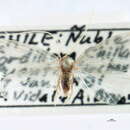Comprehensive Description
provided by Smithsonian Contributions to Zoology
Apoplania chilensis
ADULT (Figure 18).—Wing expanse: 15–19 mm.; , 20 mm.
Head (Figures 28–32): Vestiture stramineous to pale ochreous. Eyes large, interocular index approximately 1.35. Antennae whitish below, light tan above, 94–96 segmented; sensory scales arranged mostly in two bands (distal and medial) of alternating longitudinal rows; each row usually with 4 or 5 raised sockets (Figure 20); interspersed between distal rows at edge of segment are solitary sockets containing large sensory setae; microtrichiae largely restricted to basal third of each segment. Maxillary palpi and galeae whitish. Labial palpi whitish ventrally, pale tan dorsally.
Thorax: Dorsum pale tan, venter whitish. Legs pale tan to whitish; tibial and tarsal segments ringed with brown; usually two rings present on each tibia; distal ring the broadest; tarsal segments predominantly brown. Forewings translucent, thinly scaled, mottled with irregular patches of brown and white; scales slender with acute apices; a conspicuous brownish patch at wing apex and a slender, oblique streak of brown from outer third of costa across radial veins to Ml. Hindwings similarly clothed, less mottled with brown, with two conspicuous brownish patches corresponding to those mentioned in forewing; namely, a slender, triangular patch from outer third of costa to M1, an apical patch extending from R1 to M1.
Abdomen: Sparsely clothed with slender scales; pale tan above, more whitish beneath. Female with caudal margin of seventh sternite bearing approximately 30 stout, short, spinules on and around median lobe.
Male genitalia (Figures 84–87): Uncus broad and ventrally concave at base; apex narrowly divided nearly 0.5 its length. Socii reduced, narrowly separated, and situated on a bulbous, membranous anal pad. Tegumenal lobes evenly rounded, approximately 0.3 the length of valves. Gnathos a relatively flat plate, without any median process projecting ventrally, but with a median extension of plate caudad bearing numerous short, stout spines. Valvae relatively narrow, without lobes or processes; apex subacute. Median excavation of vinculum shallow, lateral arms short, broadly rounded. Juxta peltate, with a bilateral pair of compressed arms extending caudad. Anellus a narrow ring, developed dorsally (of aedeagus) into a bilateral pair of sinuate processes projecting ventrally, surpassing length of valvae. Apex of aedeagus with an irregular series of approximately five large spines radiating outward in a somewhat spiral manner from main shaft of aedeagus; ejaculatory duct with heavy, sclerotic thickenings for a distance of 1.5 times the length of the adeagus.
MAP 2.—Distribution of Apoplania chilensis, new species.
Female genitalia (Figures 96–98): Apex of ovipositor with a bluntly rounded median lobe and a bilateral pair of minute, acute lobes. Lateral margins of ninth tergite produced into a bilateral pair of rounded, setigerous lobes on either side of ovipositor apex. Caudal margins of eighth sternite truncate. Ductus bursae short, very broad, heavily thickened internally by three bilaterally symmetrical pockets or folds. Corpus bursae long and rather narrow, over 3.0 the length of posterior apophysis.
HOLOTYPE.—Chile, Nuble Province, Recinto, elevation approximately 1000 m, , 4–6 Mar. 1968, coll. Flint and Peña, USNM 72098; in the National Museum of Natural History, Smithsonian Institution.
PARATYPES.—CHILE: Linares Province: Fundo Malcho [50–60 km east of Parral], Cordillera Parral, elevation approximately 600–1000 m, 3 , 11–20 Nov. 1964 (USNM); 2 , same data (LEP); 1 , same data (BMNH). Maule Province: Costa Maule, Pelluhue, 600 m, 1 , 2 Dec. 1953 (USNM). Described from a total of seven males and one female.
DISTRIBUTION (Map 2).—Known only from heavily forested areas of central Chile between latitudes of 35°S to 37°S at elevations of 600 to 1000 m.
- bibliographic citation
- Davis, Donald R. 1975. "Systematics and Zoogeography of the Family Neopseustidae with a proposal of a New Superfamily (Lepidoptera: Neopseustoidea)." Smithsonian Contributions to Zoology. 1-44. https://doi.org/10.5479/si.00810282.210
Apoplania chilensis: Brief Summary
provided by wikipedia EN
Apoplania chilensis is a species of moth belonging to the family Neopseustidae. It was described by D.R. Davis in 1975. It is known from heavily forested areas of central Chile at elevations of 600 to 1,000 meters.
The wingspan is 15–19 mm for males and about 20 mm for females. It occurs in forest habitats dominated by plant genera as Nothofagus and Chusquea. Most of its known range lies within the faunal region characterized as the Northern Valdivian Forest. The holotype of Apoplania chilensis was collected during the day by sweeping bushes bordering a mountain stream near Recinto. All paratypes were collected at night from a white sheet suspended before a gasoline pressure lantern.
- license
- cc-by-sa-3.0
- copyright
- Wikipedia authors and editors

